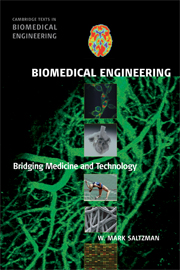Book contents
- Frontmatter
- Contents
- Preface
- Acknowledgments
- Abbreviations and Acronyms
- 1 Introduction: What Is Biomedical Engineering?
- PART 1 MOLECULAR AND CELLULAR PRINCIPLES
- PART 2 PHYSIOLOGICAL PRINCIPLES
- PART 3 BIOMEDICAL ENGINEERING
- Appendix A Physiological Parameters
- Appendix B Chemical Parameters
- Appendix C Units and Conversion Factors
- Index
- Plate section
- References
1 - Introduction: What Is Biomedical Engineering?
- Frontmatter
- Contents
- Preface
- Acknowledgments
- Abbreviations and Acronyms
- 1 Introduction: What Is Biomedical Engineering?
- PART 1 MOLECULAR AND CELLULAR PRINCIPLES
- PART 2 PHYSIOLOGICAL PRINCIPLES
- PART 3 BIOMEDICAL ENGINEERING
- Appendix A Physiological Parameters
- Appendix B Chemical Parameters
- Appendix C Units and Conversion Factors
- Index
- Plate section
- References
Summary
LEARNING OBJECTIVES
After reading this chapter, you should:
Be familiar with how changes in medicine have enhanced life span and quality of life.
Understand a few examples of the role of engineering in defining medical treatments.
Have developed your own definition of biomedical engineering.
Understand some of the subdisciplines that are included in biomedical engineering.
Understand the relationship between the study of biomedical engineering and the study of human physiology.
Be familiar with the structure of this book, and have developed a plan for using it that fits your needs.
Prelude
The practice of medicine has changed dramatically since you were born. Consider a few of these changes, some of which have undoubtedly affected your own life: Couples can test for pregnancy in their homes, a new vaccine is available for chicken pox, inexpensive contact lenses provide clear vision, artificial hips allow recipients to walk and run, ultrasound imaging follows the progress of pregnancy, and small reliable pumps administer insulin continuously for diabetics. For your parents, the changes have been even more sweeping. Overall life expectancy—that is, the span of years that people born in a given year are expected to live—increased from 50 in 1900 to almost 80 by 2000 (Figure 1.1). You can expect to live 30 years longer than your great-grandparents; you can also expect to be healthier and more active during all the years of your life.
- Type
- Chapter
- Information
- Biomedical EngineeringBridging Medicine and Technology, pp. 1 - 28Publisher: Cambridge University PressPrint publication year: 2009
References
- 1
- Cited by

